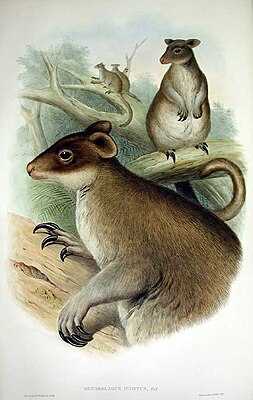Gray tree kangaroo
| Gray tree kangaroo | ||||||||||||
|---|---|---|---|---|---|---|---|---|---|---|---|---|

Gray tree kangaroo ( Dendrolagus inustus ) |
||||||||||||
| Systematics | ||||||||||||
|
||||||||||||
| Scientific name | ||||||||||||
| Dendrolagus inustus | ||||||||||||
| Müller , 1840 |
The gray tree kangaroo ( Dendrolagus inustus ) occurs in western New Guinea. Dendrolagus inustus inustus , the nominate form lives on the Vogelkop and Bomberai peninsulas and possibly also on the islands of Waigeo , Misool , Salawati and Batanta , the subspecies Dendrolagus inustus finschi , occurs in the northern coastal mountains from Wewak in the east to Cenderawasih Bay in the west and on the offshore island of Yapen .
features
The gray tree kangaroo is a relatively large, long-tailed tree kangaroo. Females reach a head trunk length of 55 to 89 cm, the measured males were 57 to 80 cm long. The tail is 64 to 84 cm long in the females and 71 to 96 cm long in the males. The weight of the females is 7 to 14 kg, that of the males 11 to 23 kg. The animals are dark brown-gray on the back, sometimes with a reddish tinge. The head, neck, abdomen, limbs and tail are lighter gray. The toes are black. The face above the eyes is dark gray-brown to black. The ears are large, largely hairless on the inside and black. The tail is covered in some specimens with short, in others with long, woolly hair and can be slightly curled light and dark. Large patches of hairless skin are found at the base of the tail. In Dendrolagus inustus finschi , the face should be darker and the tint of the limbs and tail should contrast more strongly with the color of the body.
Habitat and way of life
The gray tree kangaroo lives in tropical rainforests at heights of 100 to 1400 meters above sea level. It feeds mainly on the leaves of trees, climbing plants and ferns. It eats both in the trees and on the ground. Little is known about reproduction. Females have a single cub per year. This remains in the bag for 6 months and leaves the mother when it is around 12 months old. Females become sexually mature at 17 months of age. The sexual dimorphism in terms of size suggests that the males are in intense competition for the females. Gray tree kangaroos usually live individually.
The gray tree kangaroo is classified as endangered ("Vulnerable") by the IUCN . The main reasons are the increasing hunting pressure from humans and the loss of habitat due to conversion into agricultural land.
Individual evidence
- ^ A b c Mark Eldridge & Graeme Coulson: Family Macropodidae (Kangaroos and Wallabies). Pages 703-704 in Don E. Wilson , Russell A. Mittermeier : Handbook of the Mammals of the World - Volume 5. Monotremes and Marsupials. Lynx Editions, 2015, ISBN 978-84-96553-99-6
- ↑ Dendrolagus inustus in the Red List of Threatened Species of the IUCN 2016. Posted by: Leary, T., Seri, L., Wright, D., Hamilton, S., Helgen, K., Singadan, R., Menzies, J. , Allison, A., James, R., Dickman, C., Aplin, K., Flannery, T., Martin, R. & Salas, L., 2016. Retrieved March 20, 2018.
